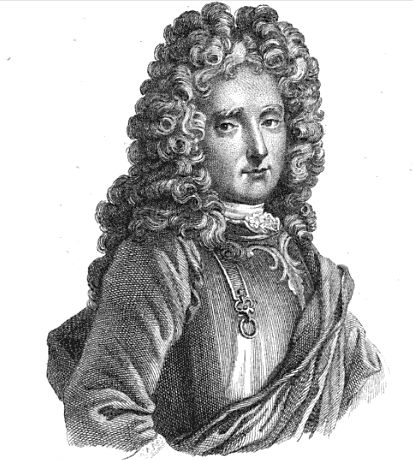ANTOINE HAMILTON.
Antoine/ Anthony Hamilton (1646-1720) was an Irish nobleman and author who wrote in French. He was born in Roscrea, Tipperary, but until the age of four he lived in France, where his family, as Roman Catholics, had fled after the execution of Charles I. In 1661, after the enthronement of Charles II, he was allowed to return to England, where he mixed in court circles, and 1668 he started a military career in France, serving in the French army with a British regiment during the Franco-Dutch war. In 1685 he came into the service of the British army until 1690. He spent the rest of his life mainly in France. His major literary work was Mémoires du comte de Gramont which was published in 1713 in the Dutch Republic and which depicted life at the English court allegedly dictated by Gramont. In 1730 a collection of fictional tales appeared inspired by the Mille et une nuit of Antoine Galland, Le belier, Fleur d’Épine, Zeneyde, and Les quatre Facardins, which were the first examples of the many 18th century parodies of the Thousand and one nights.
The fragments:
Between 1694 and 1715, partly for the entertainment of a friend, Henrietta Bulkley, the sister of Anne, Duchess of Berwick, Hamilton wrote four tales based upon the example of Galland’s Mille et une nuit, which circulated in manuscript until they were printed in 1730. The tales, which were quite popular and were reprinted several times during the 18th century, are humoristic, sometimes even farcical, and show a remarkable sense of extravagancy or, in today’s terminology, of surrealism. They were published in English in 1849. Some consider the extravagant style of the stories as a precursor of the later orientalist novels by Crébillon fils and Diderot and the satirical, libertine novels of the 18th century. The story of Fleur d’Épine is told by Shahrazad’s sister Dinarzade to Shahriyar and is about a princess, named Luisante, whose eyes are so bright that any man who looks at her dies. Prince Tarare, in disguise, promises to save her from this curse with the help of the fairy Sérène. They have to rescue the princess from the curse of the horrible fairy and bring a magical hat and the musical horse Sonnante, besides a portrait of Luisante. Tarare fulfils all these tasks and returns with a magic potion which cures the princess. La Harpe remarked about the story: ‘L’objet en est moral et très agréablement rempli, c’est de faire voir qu’avec beaucoup d’esprit, de courage et d’amour, un homme sans figure et sans fortune peut vaincre les plus grands obstacles; et que dans les femmes la grâce l’emporte sur la beauté. Hamilton devoit en effet vanter la grâce; son style en est plein.’ (Kissenberth, p. 92) The story Les quatre Facardins is about a prince of Trabizond, son of the brother in law of Schah-Riar, who relates how he received his name: Realizing that a name determines the fate of whoever carries it, at the prince’s birth his mother hesitates. Then a parrot pronounces the name Facardin which is subsequently adopted for the newly born. As an adolescent, Facardin roams though the world and meets another adventurer also named Facardin, who tells him his life story. Later he hears that two other persons bear the same name. Here the story ends uncompleted, but apparently it was later supplemented by a certain Pierre Marc Gaston de Levis. The stories by Hamilton are entertaining parodies of the fairy tale genre, and the Oriental tale more particularly. They not only explicitly present themselves as sequences of the Thousand and one nights, but also contain many motifs referring to it.

Sources/references:
Wilhelm Kissenberth, Antoine Hamilton, sein Leben und seine Werke, Gustav Schade, Berlin 1907.
Edward Corp, ‘Hamilton, Anthony,’ Oxford dictionary of national biography, Oxford University Press, Oxford etc. 2004.
‘Hamilton, Anthony,’ Dictionary of national biography, Smith, Elder & Co., London 1885-1900.
Pierre-Andrè Sayous, Histoire de la literature francaise à l’etranger, Cherbulier, Paris 1853.
Ruth Clark, Anthony Hamilton: his life and works and his family, John Lane, London 1921.
Marie-Louise Dufrenoy, L’Orient Romanesque en France (1704-1789), 3 vols., Beauchemin/ Rodopi, Montreal/ Amsterdam 1946-1975.
Pierre Martino, L’Orient dans la literature francaise au XVIIe et XVIIIe siècle, Hachette, Paris 1906.
Weblinks:
http://gutenberg.org/author/Hamilton,+Anthony,+Count (Project Gutenberg)
https://archive.org (Internet Archive)
http://viaf.org/viaf/281518656 (Fichier d’Autorité International Virtuel)
http://isni.org/isni/0000000141018846 (International Standard Name Identifier)
http://catalogue.bnf.fr/ark:/12148/cb11906786s (Bibliothèque Nationale de France)